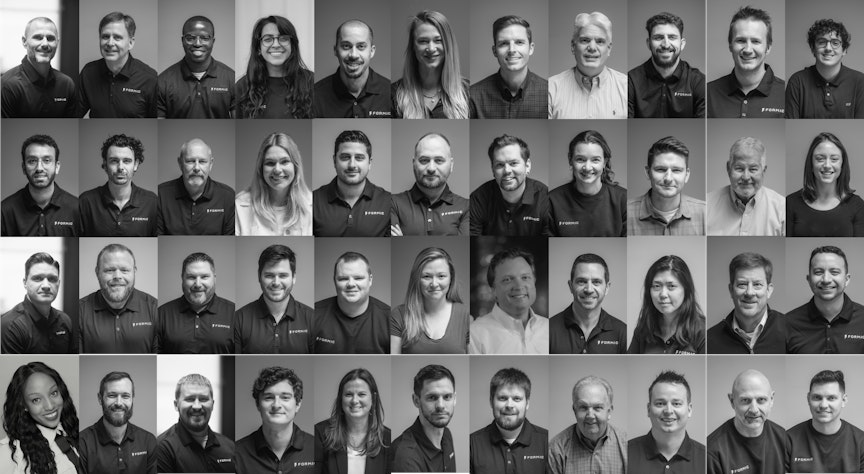Kyle Kidwell, an application engineer at Formic. Responsible for evaluating potential automation applications, managing projects, and engaging with customers.
What is your proudest accomplishment working at Formic?
I would say my proudest accomplishment doesn’t necessarily have anything to do specifically with individual effort. I would say that as a team we have worked to develop a system that allows us to deploy a robot a lot quicker and is improving our time to quote, our time to get a contract in front of somebody, and ultimately work towards closing that deal with a customer. We have turned these long quoting times and long scoping times down to only spending maybe a week or less. That is something I feel is a great team accomplishment because it is helping us leverage our skill sets variously throughout the company, and will help us in the future.
Your previous position was at Universal Robots. I want to hear how your experience there differs from how things work at Formic.
Essentially, I had a couple different roles throughout my time at Universal Robots. One was listed as a technical support engineer and the other one was an applications engineer. A lot of that was mainly about training, servicing, and supporting customers. That differs from what we do here because being on the OEM side, you are going in to put out fires. You are gonna be doing firefighting and troubleshooting to figure out what’s wrong with the system. Whereas here at Formic, we are trying to be more proactive upfront. We take ownership of a system. Everything that could go wrong, we try to put on our own shoulders as a company.
We are really trying to put the best foot forward to make life easier for the customers, for the small guys who maybe are not as familiar with automation or this type of equipment. To be able to deploy, service, maintain, and have the confidence that the systems can stay running day-in and day-out could be a heavy burden for these customers. I think that was one of the biggest keys that really attracted me to coming over to Formic. Typically, the OEMs, the customer, the integrator, and these various different parties get involved with a project and nobody really knows where the responsibilities are gonna fall. Here, we are saying, the responsibilities are on our shoulders. We will do what needs to be done to get the system up and running.
Why do you think many manufacturers are hesitant to implement automation?
Automation can be a pretty scary process for manufacturers because they may look to get a project scoped by an integrator, and once they get a quote, they receive a huge price tag. They have to decide right there, do they want to spend half a million dollars on a project or not. There is a lot of uncertainty on whether or not that half a million dollar investment is actually going to yield results. Are there any hidden costs behind the curtain? Also, there is no guarantee that it will work once the system is implemented. It is just dropped on to the shop floor and they say sorry, here you go and you are just left on your own.
At Formic, we oversee the entire process. Our engineers take a look at the application, farm it out to different integrators for an estimate. As soon as we find a bid that is reasonable and could provide the customer with a good solution, we present them an hourly rate. After the contract is signed, our engineers work directly with the integrators to build the system. From the day the robot is on the shop floor, our customers can potentially start to see a ROI. Whereas with the traditional investment, they will usually be looking around the 16 to 20 month range to be able to realize the ROI after the system is running. With our model, we can help them save money 6 to 7 months prior to what they would normally see in a capital perspective.
Some may be wondering, what can I start automating right now? What are some common or easy applications of automation?
One of the easier applications would be end-of-line palletizing. It lends itself well to quick and easy automation. If you have something with a certain range of boxes under the 20 pound range, and you have basic part patterns, not running too fast or too aggressive, you can get systems that are readily available to be deployed. Another one that is on a quick hit range would be CNC machine tending. In particular, lathes are really appealing from an automation perspective because the machine tool is only able to take a certain volume of parts. The positions are going to be fixed so even if you have to adjust some points on the robot side, it lends itself to being a quick implementation.
What are some common concerns that manufacturers may ask or approach you with?
A question we get a lot from customers is what happens if it doesn’t work? How do you anticipate that you can service these systems within a reliable time? A lot of questions are related to what happens if something happens. Our approach to that is we have a cured structure that allows us to monitor the systems remotely. If we see a trigger or see a fault, we’re proactively starting on the case to figure out what went wrong and how we can resolve it. When we need to, we escalate the processes to the OEMs or the engineers and experts that know and understand the nitty gritty details of the system. They are the ones who can engage and get this up and running.
What do you hope to see Formic achieve in the next 5 to 10 years?
I hope that we are turn into a corner-stone for automation. Essentially we are the first choice that people think of when they are looking to deploy a system or looking to improve a manufacturing process or overcome any obstacles they may see.
The labor picture will look very different in that time period than it does today. I think we can lend ourselves very well to being a good choice to customers who are looking to automate, but we can also leverage our company. We can have a second tier training, education program to help people get more familiar with supporting, deploying, and implementing automation systems.
Kyle Kidwell


